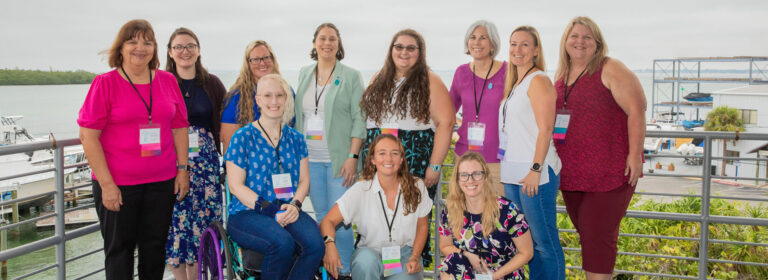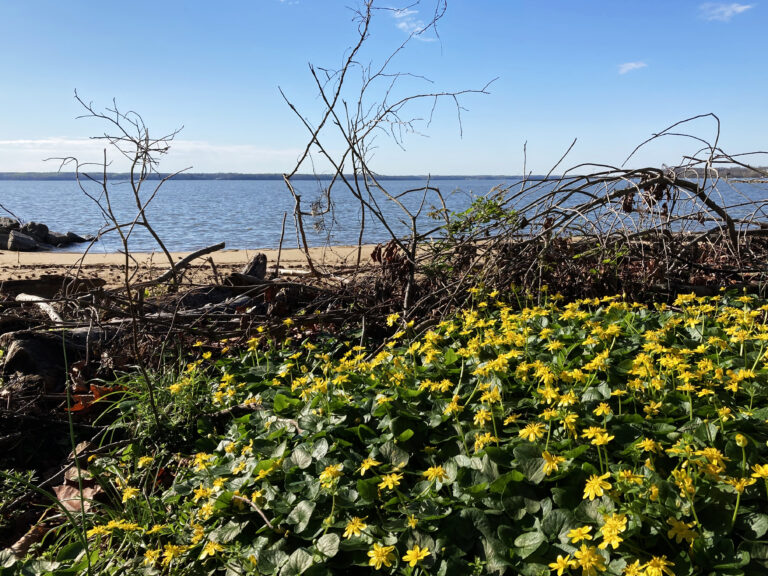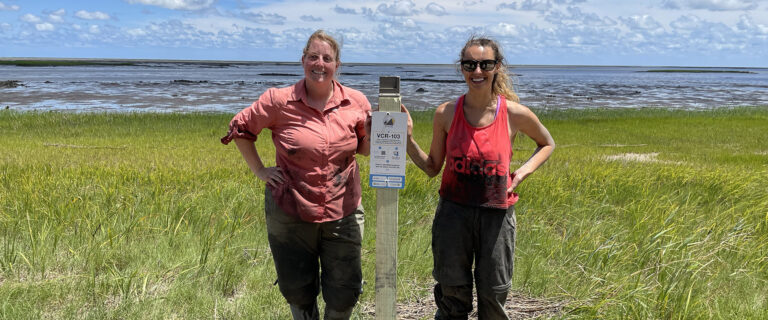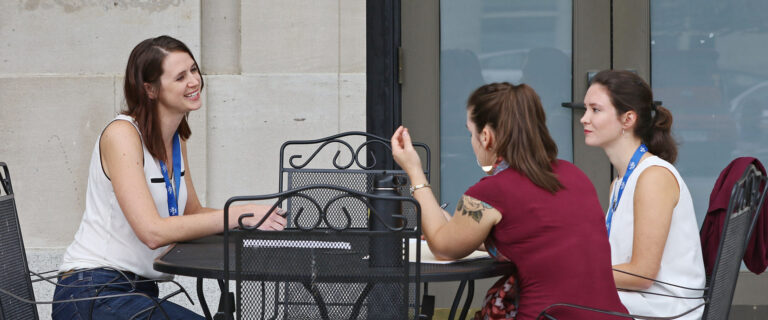
Community, Inclusivity, and Connection: The Women of the Water Conference
Community, Inclusivity, and Connection: Reflecting on the 2023 Women of the Water Conference By Kaitlyn Theberge | Virginia TechBy Hayley Lemoine | Florida
By Qiong Wang | Virginia Tech
By Yao Wang | State University of New York
“As you prepare for the dual roles of scientist and science communicator… ask yourself, can you explain your research to a 7th grader?” When we saw this question posted by Michelle Rodriguez, Virginia Sea Grant professional development coordinator, in the recruitment email for the Virginia Scientists & Educators Alliance (VA SEA) lesson plan project, we immediately applied. This is because our career goal is to become professors working on disaster resilience and climate change adaptation in a research university.
We realized that the VA SEA project could provide a great opportunity to create a lesson plan for K-12 students and teachers around the globe based on our current research. Although the lesson plans would be intended for middle and high school classrooms, the logic behind lessons for younger audiences was the same. This will address the challenge of developing interactive, hands-on lectures that are age-appropriate.
The objective of our lesson plan is to provide students with an understanding of what the zoning ordinance is and to learn about specific strategies to reduce disaster risk and enhance resilience. The Resilience Quotient zoning ordinance solves coastal resilience development challenges in Norfolk, Virginia. The Resilience Quotient refers to a point system, where credit is allocated for specific actions that developers can use to meet requirements to reduce disaster risk. Our lesson plan covers fundamental resilience concepts and strategies as well as provides an in-class activity with three scenarios to help students learn how the Resilience Quotient can play a role in the city’s coastal development.
A key feature of our lesson plan is the hands-on activity where students can practice how the Resilience Quotient works. Students will be divided into single family, multi-family, and non-residential development groups. They will find the requirements of their projects, then select interventions from the tables and calculate points and costs to meet the requirements. Students also will need to consider the benefits of interventions based on the appendix materials.
In the lesson, students will learn key concepts of climate change, zoning ordinance, and relationships between them. Since the information is too abstract for students to understand, we used real-life examples and images with simple terms to interpret three components of the Resilience Quotient, including risk reduction, stormwater management, and energy resilience.
For example, elevation of a home is an intervention in the risk reduction component. Students can learn the specific standard of elevation in Norfolk: the lowest habitable floor and all significant electrical and mechanical equipment shall be elevated at least 16 inches above the highest existing base level at the front of the structure. This information along with a home elevation image can help students easily understand the concepts. A local oceanography teacher also provided feedback: “The lesson plan was very nicely done with the learning styles and difficulty level. The information would be good for my students to read and understand. You define the key words for the students which helps.”
We also prepared 3D files for students to print the city map using a laser cutter. The 3D tool will visualize the layer of water, land, and streets. Students can use this technology to research and solve problems from an early age to better prepare them for their careers. After we presented our lesson plan at the expo, one of the mentors said, “This is the first time that the VA SEA lesson plan project integrated the hands-on 3D printing of a city map into a lesson plan. I think it’s a really cool activity.”
At the end, students will need to answer the questions in the summary part and use maps and illustration cards to present their results. In the wrap up section, the three groups will compare their results to see different resilience requirements for different types of development. We also have an exit ticket for students to write a short paragraph and summarize their findings. This will allow individuals to demonstrate their mastery of the material.
One audience member said, “The 3D maps are great.” The aforementioned classroom teacher said, “I think the 3D helps the Special Education students and English to Speaker of Other Languages (ESOL) students see what you want them to see much better.” These compliments from mentors and classroom teachers will encourage us to continue to innovate in our future work. Please find our lesson plan on the VA SEA website here.
We also prepared 3D files for students to print the city map using a laser cutter. The 3D tool will visualize the layer of water, land, and streets.
Graduate students at VASG-affiliated universities are invited to engage in a yearlong lesson plan development project in which they will learn best practices for conveying their research by developing lesson plans for middle and high school courses.
The Chesapeake Bay National Estuarine Research Reserve in Virginia and the Virginia Institute of Marine Science (VIMS) launched the VA SEA Lesson Plan project in 2015. Graduate students at VASG-affiliated universities are invited to engage in a yearlong lesson plan development project in which they will learn best practices for conveying their research by developing lesson plans for middle and high school courses. To date, the project has drawn 48 graduate students and produced 54 lesson plans.
The structure of the project is well-designed. Graduate students benefit not only from the ultimate result of publication, but also from the process of being mentored. The VA SEA lesson plan project usually begins accepting graduate students in July for the following academic year. Ten students are selected in early August, and they need to participate in two workshops hosted by the VIMS in August and September.
During the workshops, fellows can obtain detailed information about the project including timeline, lesson formatting, image use and copyright, and publishing. Moreover, they can also learn about science education best practices, lesson plan design, demonstrations of exemplar VA SEA lessons, and have opportunities to communicate with classroom teacher panelists.
In addition, the mentors at VIMS offer at least three lesson plan development check-in sessions after the workshops. From December through March of next year, the mentors and local classroom teachers will review and pilot the lesson plans. Graduate students can then update the lesson plans based on their feedback.
Lastly, we would like to thank all the mentors from the VIMS for their help and support with the lesson plan. They are Lisa Lawrence, Sarah Nuss, Celia Cackowski, Tara Rudo, and Bethany Smith. We appreciated that Bruce Pencek and Edwin Brooks, who are working at Virginia Tech library, helped with the Norfolk contour data. Please find more information about the VA SEA program on this website.
Qiong Wang is a Ph.D. Candidate in Planning, Governance & Globalization and a Disaster Resilience and Risk Management (DRRM) scholar at Virginia Tech studying hazard mitigation policy. She is also a VASG graduate research fellow working on the modifications of the Resilience Quotient zoning ordinance in the city of Norfolk, Virginia with city planners and experts.
Yao Wang is a Ph.D. Candidate in Environmental Science (Policy, Planning, Communication and Society) at the State University of New York College of Environmental Science and Forestry (SUNY-ESF) studying climate change adaptation and community engagement. She works as a teaching assistant at the Digital Fabrication Lab on 3D models utilizing laser cutters, 3D printers, CNC Routers, and other 3D model machines and programs.
Photos contributed by Qiong Wang | Virginia Tech
Video contributed by Yao Wang | State University of New York
Photos contributed by Tara Rudo | Chesapeake Bay National Estuarine Research Reserve
Published May 12, 2022.
To date, the project has drawn 48 graduate students and produced 54 lesson plans.

Community, Inclusivity, and Connection: Reflecting on the 2023 Women of the Water Conference By Kaitlyn Theberge | Virginia TechBy Hayley Lemoine | Florida

The Virginia Sea Grant Commonwealth Coastal & Marine Policy Fellowship has given me the opportunity to learn some more broadly practical jargon.

Armed only with a phone, visitors can use our tool to document coastal changes with repeat photography.

It’s that time of the year again! No, I’m not talking about fall — although sweater weather, hot apple cider, the changing leaves, and Halloween make this my favorite season — but the semester where Virginia Sea Grant is seeking applicants for their fellowship.